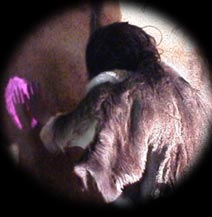 |
|||||
 |
|||||
|
Evolution History Map |
|||||
| Homo sapien, had a brain size between 1350-1400cc and are the closest species to modern humans, emerging 100,000 years ago. The brain-to-body ratio is high and the forebrain, the seat of reason, is exceptionally large. They were the first known verbal communicators, having speech abilities, and were the first artists. This speech ability was due to the evolutionary growth in the brain taking place over the previous million years, in which the brain acquired one extra pound of neural tissue in the neocortex. During this evolutionary growth from the previous 1,000,000 years, the brain's functions split in two into right/left hemispheres--a revolutionary development that also enabled humans the ability to speak.
Homo sapien artwork has been discovered in caves such as Lascaux that is considered to be the most beautiful Paleolithic painted cave in the world. It contains more than 1500 pictures of animals dating back to 17,000 years ago.
Anthropologists have discovered "hand paintings" in caves all over the world, many of which were created thousands of miles a part and date up to 20,000 years ago. They are considered the first universal "icon" form of world communication. The artists created their hand paintings by placing their hand on a cave wall and painting over it as shown above. Among the cave art, archeologists have also uncovered evidence that Homo sapiens, beginning in the peolithic period of 25,000 B.C., worshipped Goddesses on a universal scale. Goddess figures have been uncovered from all over the world, including Europe and the near and middle East. Theories* exist that the worship of female deities had a great deal to do with the right brain hemisphere dominating these early hunter/gather sapien cultures. The rapid decline of the Goddess worshipping cultures appears to have occurred at the time literacy was born, that is a left brain dominated function. Photos - California Academy of Sciences, *The Alphabet versus the Goddess, Leonard Shlain, M.D., From Lucy to Language, |
|||||
